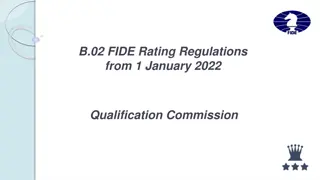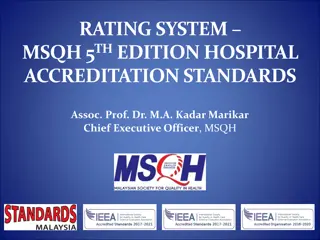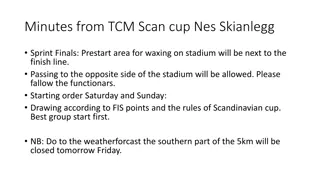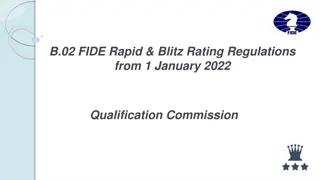Overview of 38 CFR Part 4 Rating Schedule
This class provides a general overview of 38 CFR Part 4, covering essential aspects such as evaluative rating, resolution of reasonable doubt, evaluation of evidence, and principles for assigning disability ratings. It emphasizes the importance of accurate medical exams and understanding rating percentages. The session aims to enhance understanding of VA math and offers practice opportunities to apply the regulations effectively.
Download Presentation

Please find below an Image/Link to download the presentation.
The content on the website is provided AS IS for your information and personal use only. It may not be sold, licensed, or shared on other websites without obtaining consent from the author. Download presentation by click this link. If you encounter any issues during the download, it is possible that the publisher has removed the file from their server.
E N D
Presentation Transcript
38 CFR Part 4 38 CFR Part 4 Schedule for Rating Disabilities Schedule for Rating Disabilities Michael Figlioli Deputy Director, NVS MFiglioli@vfw.org James Moss Assistant Director, Healthcare Policy JMoss@vfw.org 1
OVERVIEW This Class is designed to be a general overview and summary of 38 CFR Part 4 You do not need to memorize the regulations By the end of this session you will understand VA math After the session we will use the breakout rooms to practice VA Math 2
SUBPART A GENERAL POLICY IN RATING 38 CFR 4.1-38 CFR 4.31 3
4.1 ESSENTIALS OF EVALUATIVE RATING Explains the purpose of the rating schedule including that rating percentages represent the Average Impairment of Earnings Capacity resulting from disabilities or diseases Also explains that accurate Medical Exams are Required to determine the limitation of activity imposed by the disabling condition and that all evaluations must be viewed in relation to its history 4
4.3 RESOLUTION OF REASONABLE DOUBT When after careful consideration to all procurable and assembled data, a reasonable doubt arises regarding the degree of disability such doubt will be resolved in favor of the claimant One small paragraph, one giant effect! Does NOT mean that the VA is required to prove the disability is not related to service Require a relatively equal balance of positive and negative evidence (equipoise) Refer to 38 C.F.R. 3.102 5
4.6 EVALUATION OF EVIDENCE This regulation explains that all evidence that is part of the claim must be thoroughly evaluated and considered prior to rendering a decision 6
4.7 HIGHER OF TWO EVALUATIONS Where there is a question as to which of two evaluations shall be applied, the higher evaluation will be assigned if the disability picture more nearly approximates the criteria required for that rating. Otherwise the lower rating will be assigned. Arguably the most arguable regulation! Arbitrary - allows for assigning either a higher, or lower evaluation??? Example: A veteran has a disability with symptoms that warrant both a 30% and 40% rating. The rater should look at which rating most closely resembles the current severity of the disability and assign that rating percentage 7
4.9 CONGENITAL DEFECTS Congenital or developmental defects are NOT normallycompensable or service-connected! But Is there a way??? 8
4.10 FUNCTIONAL IMPAIRMENT The basis of an evaluation is the ability of the body, as a whole, to function under ordinary conditions of daily life. Regardless of the body system affected, evaluations are based on the usefulness of the affected body part or system The examiner must provide a full description of the effects of the disability on the veteran s ordinary activity to include employment Must be remembered that although the veteran may be up and about or can function at home, they still may be too disabled to maintain employment 9
4.13 EFFECT OF CHANGE OF DIAGNOSIS This regulation explains that if the medical evidence shows that a change in diagnosis could be assigned it must be an actual medical change based on the symptoms not on the interpretation or thoroughness of the examiner Repercussions of change This regulation is often used when rating mental health disorders (38 CFR 4.125) Ensure any changes in diagnosis align with 38 CFR 4.7 10
4.14 AVOIDANCE OF PYRAMIDING VA will not rate the same disability or symptom more than once Pay close attention to which symptoms relate to each disability as many body systems overlap and symptoms can often relate to more than one disability Special rules (exemptions) are in the Rating Schedule NSC versus SC etiologies VA is very aware of this rule! 11
4.15 TOTAL DISABILITY RATINGS Disabilities can affect people differently Ratings are based on the average impairment of earning capacity not the individuals success in overcoming it Individual success should still be measured as the VA can use it to determine a rating if the veteran does not have the average amount of success overcoming or adapting to the disability Total Disability (P&T) Ratings Disability is severe enough to prevent an average person from securing or maintaining employment A total disability rating does not mean that the veteran is not allowed to work 12
4.16 TOTAL RATINGS BASED ON INDIVIDUAL UNEMPLOYABILITY Compensation will be paid as if the veteran was rated 100% disabled if it is shown that service connected disabilities prevent the veteran from securing or maintaining substantially gainful employment. The VA must find that the veteran is unable to work due to service-connected disabilities. It is not sufficient to state that the veteran is unemployable due to nonservice-connected disabilities. To qualify for TDIU a veteran must have: A single disability evaluated at 60% or more (can be multiple disabilities based on the same etiology) or Two or more disabilities that equal a combined 70% and at least one 40% rating An extra-schedular evaluation can be granted if a veteran has an exceptional or unusual disability picture due to marked interference with employment or frequent periods of hospitalization which are not reflected by regular schedular standards. 13
4.18 UNEMPLOYABILITY A veteran may be considered unemployable upon termination of employment provided the termination was due to a disability For amputations, sequelae of fractures, and other residuals of traumatism that are static, a veteran can show continuous unemployability from date of incurrence or stabilization May be attributed to a static disability Increase in severity of combined service connected and non-service connected disabilities, 4.16 should be considered 14
4.17A MISCONDUCT ETIOLOGY The regulation explains that a veteran can still obtain a permanent and total disability even if they acquired a disability due to willful misconduct as long as: (a) The veteran has innocently acquired 100 percent disability (b) The veteran has other disabilities innocently acquired that render them unemployable 15
4.19 AGE IN SERVICE-CONNECTED CLAIMS May not be used deciding service-connected disability or unemployability as a basis to grant a total disability rating Age can be a factor in evaluations of disability not resulting from service (Non-Service Connected Pension) 16
4.27 USE OF DIAGNOSTIC CODE NUMBERS Arbitrarily assigned for showing the basis of the evaluation and statistical analysis by the VA No other numbers may be assigned with the exception of analogous diagnostic codes ( 4.20) Injuries will be represented by the number assigned to residuals conditions Diseases assigned with preference given to the disease itself 17
4.20 ANALOGOUS RATINGS An Analogous Rating will be assigned if the veteran has a disability that is not listed in the rating schedule The unlisted disability will be rated under diagnostic codes for a closely related disease or injury Instead of a 4 number code, the code will have 2 sets of 4 digits The first code identifies the body system, the second code is the closest related disability Analogous ratings are not used for organic diseases/functional disorders 18
COMMON ANALOGOUS CODES Arthralgia 5099-5003 (arthritis) Chondromalacia patellae 5099-5014 (osteomalacia) Pneumonia 6899-6845(restrictive lung disease) Mitral valve prolapse 7099-7000 (valvular heart disease) Gastroenteritis 7399-7307 (gastritis) Crohn s Disease 7399-7323 (ulcerative colitis) Colostomy 7399-7333 (rectum and anus stricture) Shingles/folliculitis 7899-7806 (dermatitis or eczema) Carpal tunnel syndrome 8599-8515 (median nerve paralysis/incomplete paralysis) 19
4.21 APPLICATION OF RATING SCHEDULE Used to sufficiently identify disease/disability Establishes criteria to ascertain level of disability or functional impairment Does not include all disabilities (analogous) Organized by body system in ranges from 0 to 100% 20
4.28 PRE-STABILIZATION RATING FROM DATE OF DISCHARGE FROM SERVICE VA can assign a 50% or 100% rating to veterans for 12 months who were recently discharged and have a disability that is still healing or not yet stable Unstabilized condition with severe disability Substantially gainful employment is not feasible or advisable = 100% Unhealed or incompletely healed wounds or injuries Material impairment of employability likely = 50% Not to be assigned in lieu of a total rating or TDIU Pre-stabilization 50% rating is not to be used in any case in which a rating of 50% or more can be assigned under regular provisions 21
4.29 HOSPITALIZATION 100% rating will be assigned for hospitalization for SC disability for a period in excess of 21 days Temporary release approved by a VA doctor as part of treatment will not be considered an absence If convalescence is required may be continued for an additional 1-3 months Additional periods may be approved by the Veterans Service Center Manager (VSCM) 22
4.30 CONVALESCENT RATINGS Total ratings will be assigned if convalescence is required or surgery with severe postoperative residuals Immobilization by cast without surgery of one or more major joints Extensions of 1-3 months beyond the initial 3 months may be made Extensions of 1 or more months up to 6 months beyond the initial 6 months may be made by the VSCM 23
4.31 ZERO PERCENT EVALUATIONS Every service connected condition can be granted a 0% rating if the criteria for the minimum compensable rating is not met This means that if the veteran has a diagnosed disability that is related to service but does not have severe enough symptoms to warrant the minimum rating in the schedule, VA can assign a 0% rating 24
38 CFR Part 4 Subpart- B Disability Rating 4.40 - 4.150 25
4.40 FUNCTIONAL LOSS Functional loss is the inability to perform the normal working movements of the body and is determined by: Strength Speed Coordination Endurance Weakness and Limitation of Motion are both important 26
4.40 FUNCTIONAL LOSS DeLuca v. Brown, 8 Vet.App. 202 (1995) States that if a veteran has a disability of a joint that is painful upon motion or repetitive use, VA should assign the minimum compensable rating or increase the rating by one level if the veteran is already entitled to a compensable rating. 27
4.41 HISTORY OF INJURY Residuals of an injury Mechanism of Injury Treatment Effectiveness Duration The absence of clear cut evidence of injury, may reflect congenital or developmental etiology, or the effects of a healed disease 28
4.42 COMPLETE MEDICAL EXAMINATION OF INJURY CASES Must include all systems of the body affected General examination Complete Neurological & Psychiatric Special Exams as indicated Orthopedic Surgical 29
4.43 OSTEOMYELITIS DC 5000 Chronic or recurring Considered continuously disabling Unless removed by amputation A permanent rating can be combined with other ratings for residual conditions 30
4.44 THE BONES Malunion Disarticulation Shortening Consider strain on neighboring joints 31
4.45 THE JOINTS Less movement More movement Weakened movement Fatigability Incoordination Pain Major Joints Shoulder, elbow, wrist, hip, knee, ankle MinorJoints Vertebrae, all smaller joints 32
4.46 Accurate Measurement Insist on accurate measurement of lengths of stumps, movement of joints and dimensions and locations of scars If an examination does not have accurate measurements, it s inadequate! Joint movement is measured by a Goniometer 33
4.55 PRINCIPLES OF COMBINED RATINGS FOR MUSCLE INJURIES 38 CFR 4.73 Schedule of Ratings DC 5301-5323 32 groups 5 regions 34
4.55 PRINCIPLES OF COMBINED RATINGS FOR MUSCLE INJURIES Muscle Injuries ratings and Peripheral Nerve Paralysis ratings cannot be combined if they are part of the same body part unless they affect different functions If a joint is Ankylosed, the muscles that act on thatjoint will not be rated Exceptions: Knees, Shoulders 35
4.55 PRINCIPLES OF COMBINED RATINGS FOR MUSCLE INJURIES Multiple muscles Same Region but Different joint: The evaluation for the most severely injured muscle group will be raised one level and used as the evaluation for all muscle groups in the region. Different Region: Rate separately 36
4.56 EVALUATION OF MUSCLE DISABILITIES There are 4 levels of severity for muscle disabilities: Severe Moderately Severe Moderate Slight 37
4.56 EVALUATION OF MUSCLE DISABILITIES When VA evaluates muscle disabilities they consider: Cardinal signs and symptoms (S/S) Loss of power Weakness Lowered threshold of fatigue Fatigue-pain Impairment of coordination Uncertainty of movement Type of injury Blunt trauma Gun shot Shrapnel History and complaint Type of treatment required Length of treatment Objective findings Residuals 38
4.56 SLIGHT MODERATE MODERATELY SEVERE Through & through Small high velocity or large low-velocity Debridement Prolonged infection Intramuscular scarring SEVERE Through & Through High-velocity Open comminuted fracture Extensive debridement Prolonged infection Sloughing of parts Intermuscular binding & scarring Through & through Single Bullet Simple Wound No Debridement TYPE OF INJURY One or more cardinal S/S Lowered threshold of fatigue that affects function Hospitalization Cardinal S/S Inability to keep up with work requirements Brief Treatment Return to Duty Good Function No Cardinal Signs Hospitalization/prolonged treatment Consistent complaint of cardinal S/S HISTORY & COMPLAINT Scaring/Adhesions Loss of fascia or muscle Muscle(soft & flabby or hard & swollen) Impaired function X-ray evidence of Foreign Body Scars Loss of deep fascia/muscle Impaired strength and endurance Small linear scars Some loss of fascia or muscle Decreased power when compared to other side Minimal scar No functional impairment No retained foreign bodies OBJECTIVE FINDINGS 39
4.57 STATIC FOOT DEFORMITIES Bilateral Flatfoot Must be determined if congenital or acquired Congenital Not service connected Acquired Rating based on: Arch depression Calluses Tenderness Rotation Pain With regard to exercise 40
4.58 ARTHRITIS DUE TO STRAIN Lower extremity amputation or shortening Service connection for Arthritis in joints under strain Both lower extremities Lumbar spine 41
4.59 PAINFUL MOTION Recognize painful, unstable, or malaligned joints at least the minimal compensable rating for that joint. Arthritis Objective pain Muscle spasm Active/Passive motion Weight-bearing/Non weight-bearing 42
4.61 EXAMINATION Examinations for arthritis must cover all major joints Exception Traumatic arthritis 43
4.62 CIRCULATORY DISTURBANCES Circulatory disturbances are generally rated as phlebitis Pay close attention to the lower extremity in the popliteal space 44
4.63 LOSS OF USE OF HAND OR FOOT No function remains Equally served by an amputation Hand Grasping Manipulation - Foot - Balance - Propulsion Unfavorable ankylosis Complete paralysis Special Monthly Compensation** (38 CFR 3.350) 45
4.64 LOSS OF USE OF BOTH BUTTOCKS Cannot rise from sitting/stooped position without assistance The assistance can be from their arms, another person, or an assistive device 46
4.66 SACROILIAC JOINT Lumbosacral and sacroiliac joints are considered one segment X-ray Tenderness Limitation of flexion and extension of hip Trauma is rare cause 47
4.67 PELVIC BONES Rate the Residuals Posture Limitation of motion Painful motion Muscle spasm Neuritis 48
4.68 AMPUTATION RULE Combined rating of an extremity will not exceed the rating if there was an amputation at that level Example: Veteran has 5 disabilities of the left knee and ankle which when combined equal 70% Knee level amputation (DC 5164) is rated at 60% Veteran will be rated at 60% 49
4.69 DOMINANT HAND Determined by evidence of record or testing at VA exam Ambidextrous Can only have one dominant hand Injured or most severely injured is dominant 50























